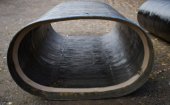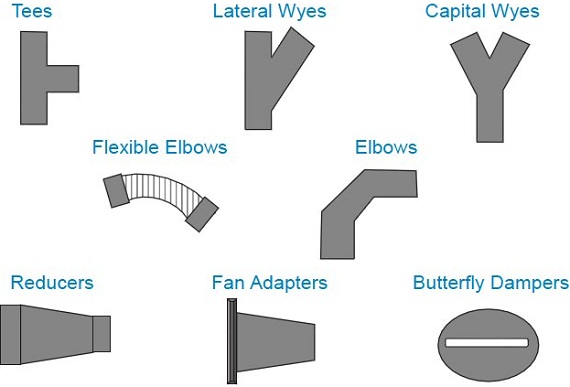Schauenburg Industries Ltd.
Fiberglass Ventilation
Phenolic Resin: The Manufacturing Difference That Results in a Better Product
 Schauenburg Industries Ltd. Fiberglass Ventilation Ducting is manufactured for use in mining and tunneling applications. Schauenburg combines a filament winding process and phenolic resin for maximum fiberglass duct strength. One of the advantages of phenolic resin is its excellent acid resistance which is a result of the acid cure process. Because phenolic resin is water based and polyester is oil based, phenolic resin is inherently flame resistant, and no fire inhibitors are added. These inhibitors detract from the strength of polyester resins making them more brittle.
Schauenburg Industries Ltd. Fiberglass Ventilation Ducting is manufactured for use in mining and tunneling applications. Schauenburg combines a filament winding process and phenolic resin for maximum fiberglass duct strength. One of the advantages of phenolic resin is its excellent acid resistance which is a result of the acid cure process. Because phenolic resin is water based and polyester is oil based, phenolic resin is inherently flame resistant, and no fire inhibitors are added. These inhibitors detract from the strength of polyester resins making them more brittle.Destruction Test
• Data was collected using a Gardner Variable Height Tester.
• Flex strength ASTM D-790.
• Flex Modulus ASTM D-790.
• Greater stiffness allows higher negative pressure capability at equal weights.
• Greater stiffness allows higher negative pressure capability at equal weights.
| Property | Schauenburg Phenolic Duct | Polyester Duct | Interpretation |
|
Impact Test (In-LBS) |
88 | 72 | Ability to resist a point impact |
|
Flex Strength (PSI) (Normalized) |
58,619 | 66,6676 | Load bearing strength |
|
Flex Modulus (KPSI) |
2325 | 1534 | Stiffness |

Destruction and Presure Test Video
Advantages & Features
• FRP upholds its integrity in a fire longer than metals. FRP will operate up to 200°C while maintaining stability.
• Fire resistant according to ASTM E-162 with flame spread index of less than 25.
• Will not promote or sustain combustion. Thermal conductivity is much lower than metals 0.20 – 0.24 w/m/k.3. Antistatic properties 10³ ohms @ 1% wt. surface resistivity.
• Noise levels are considerably lower using phenolic fiberglass skins on silencers than with metal skins due to FRP absorbing effect.
• Fiberglass Bell/Spigot ensures a safer installation – eliminating pinch points (flanged joints are available).
• FRP joints – Bell and Spigot can move 7 degrees right to left and up or down for direction.
• Available with a flanged end. Flanges are installed prior to filament winding. Flanged FRP minimizes leakage and provides stabilization from high shock waves during the blasting cycle. V-lock couplings speed up installation.
• FRP is less than half the weight of steel. For example a FRP Oval (36x62) x 20’ = 400 lbs approximately, whereas the identical sized steel vent would be approximately 1,000 lbs.
• Low installation cost due to lightweight pipe.
• FRP joints are manufactured complete with internal rubber gaskets to prevent leakage and reduce resistance at the joints.
• When subject to loading or impact, FRP springs back to shape (memory), while metal will dent and leak and may start to recoil.
• Smooth interior to guarantee low flow resistance and therefore an increase in powwer savings.
• FRP is EMR/CSA and MSHA approved for underground.
• Can withstand high positive and negative pressures.
• Acid mine water resistant and rot proof.
• FRP quick repair kit is available.
• Long service life.


Construction
• Filament wound fiberglass ducting.
• Smooth inner surface – low friction loss.
• Tapered and straight ends for airtight joints.
• Easy installation – guaranteed fit.
• Strong steel straps with D Rings for interlocking of sections and/or suspension for added strength and safety.
• Tapered ends specially reinforced.
Suspension Hangers (straps) are an inexpensive way to eliminate costly chain or rope and damage to ducting. They are strong and durable and can be suspended from one common hook or from 2 to limit swaying. The Suspension Hangers (straps) can be manufactured to fit any size of round or oval ducting.
Schauenburg fiberglass ducting is manufactured using phenolic resins. One of the main attractions of phenolic materials is its fire performance. The table below shows some typical fire test results for phenolic/glass composites and compares these to polyurethane and polyester.
Fire Properties of Phenolic/Glass Composites Compared with Polyurethane and Polyester
| Property | Phenolic | Polyester | Rigid Polyurethane |
| ASTM D229 - Oxygen Index | 45-55* | 40 | 20-25 |
| ASTM D229 - Rate of burning | Does not ignite | - | - |
| BS 476 PT.7 - Spread of Flame | Class 1 (Zero Spread) | Class 1 | Class 1 – Class 4 |
| Toxicity of combustion products | Very low | Toxic | Toxic |
| Smoke | Virtually NIL | Very high | Very high |
| * Catalyst Dependent |
When phenolic resin fiberglass ducting is exposed to fire they char on the surface which further protects the underlying layers from the heat source. In extreme conditions when fire does destroy the product only gasses of Carbon, Hydrogen and Oxygen are produced. This in essence means that the phenolic will and can only finally break down to form Carbon Dioxide, Water and Carbon Monoxide. These gasses will result from any form of combustion. A most significant factor is also the very low levels of visible smoke produced. See test results.
Phenolam Laminate Test Results
| Test – Flammability | ASTM Test | Results | |
| NBS Smoke Chamber | E-622 | ||
| D16 | >5 min. | ||
| Dmax | 42 | ||
| Radiant Panel Test | E-162 | 6.7 | |
| Tunnel Test | E-84 | ||
| FS1 | 19 | ||
| Smoke | 12 | ||
| Limiting Oxygen Index | D2863 | 67 | |
|
Thermal |
|||
| Heat Deflection @ 264 psi | D-648 | >570°F | |
| Linear Thermal Expansion | 2.93 x 10.5 m/in. °F | ||
| Specific Heat @ 50°C | 0.3 cal/ g°F | ||
The physical properties of phenolic fiber reinforced composites are retained to at least 200°C at which temperature other matrix resins have generally degraded substantially. The inherent fire properties of phenolic resins composites are excellent having the highest fire rating in all test methods, extremely low smoke emission and virtually no toxic combustion products. E.M.R. Flame Certificate Number 395.
Fire Retardency and Flammability Video
 Round filament wound fiberglass ducting is manufactured in a technically advanced process of bonding plastic resin and fiberglass strands. Due to its round shape and the outstanding strength Schauenburg Fiberglass Round Ducting withstands high positive and negative pressure and resist impacts caused by moving equipment, flying rocks and rough handling. Standard sizes range from 12” to 60” diameter. Standard lengths are 10’ and 20’ (homogeneous, no splice).
Round filament wound fiberglass ducting is manufactured in a technically advanced process of bonding plastic resin and fiberglass strands. Due to its round shape and the outstanding strength Schauenburg Fiberglass Round Ducting withstands high positive and negative pressure and resist impacts caused by moving equipment, flying rocks and rough handling. Standard sizes range from 12” to 60” diameter. Standard lengths are 10’ and 20’ (homogeneous, no splice).
Oval filament wound fiberglass ducting is an efficient way to handle todays high environmental requirements under restricted space conditions
Oval filament wound fiberglass ducting is the most efficient way to handle today’s high air requirements in mine ventilation under low space conditions. The special shape and exceptional smooth inner surface guarantee lowest friction and a high volume of air. Oval Fiberglass Ducting can be used for both negative and positive pressure ventilation systems. Standard sizes available from 14” equivalent (10 x 19) to 48” equivalent (36 x 62). Standard lengths are 10’ and 20’ (homogeneous, no splice). Fan adapters and fit tings are also available.
New Headings
Schauenburg Fiberglass Oval Rigid Ducting enables you to develop new headings at a reduced cost. These savings will likely pay for the total ventilation system. A lower back height will require less muck removal which will equal a reduced development cost.
Existing Drifts
 The Oval Duct can be used in existing drifts and X cuts, thus allowing the operation of larger LHD equipment without reduction of air volume or clearance. The duct can be installed with the long axis horizontal, or vertical if an existing drift has a low back height.
The Oval Duct can be used in existing drifts and X cuts, thus allowing the operation of larger LHD equipment without reduction of air volume or clearance. The duct can be installed with the long axis horizontal, or vertical if an existing drift has a low back height.
• Special sizes, lengths and wall thickness available on request.
• Fittings for all applications are fabricated from flame retardant, corrosion resistant material.
• Elbows 30, 45, 60, and 90.
• Flexible Elbows.
• Tees.
• Standard Wyes with 60° take off, 45° take off.
• Symmetrical Wyes with 45° take offs.
• Parallel take off Wyes and symmetrical.
• All Wyes are available with 1 or 2 dampers.
• Reducers and transition pieces.
• Fan Adapters.
• Flanged or Bell & Spigot Connections.
• Special shapes available on request.






